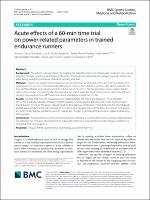Please use this identifier to cite or link to this item:
https://repositorio.usj.es/handle/123456789/872
| Title: | Acute efects of a 60‑min time trial on power‑related parameters in trained endurance runners |
| Authors: | Cartón-Llorente, Antonio

Roche-Seruendo, Luis Enrique 


Mainer Pardos, Elena 


Nobari, Hadi 


Rubio Peirotén, Alberto 
Jaén-Carrillo, Diego 


García-Pinillos, Felipe 


|
| Keywords: | Fatigue; Athletic performance; Technology assessment; Running |
| Issue Date: | 24-Jul-2022 |
| Publisher: | BioMed Central Ltd |
| Citation: | Cartón-Llorente, A., Roche-Seruendo, L.E., Mainer-Pardos, E. et al. Acute effects of a 60-min time trial on power-related parameters in trained endurance runners. BMC Sports Sci Med Rehabil 14, 142 (2022). https://doi.org/10.1186/s13102-022-00538-7 |
| Abstract: | Background: The advent of power meters for running has raised the interest of athletes and coaches in new ways of assessing changes in running performance. The aim of this study is to determine the changes in power-related variables during and after a strenuous endurance running time trial. Methods: Twenty-one healthy male endurance runners, with a personal record of 37.2 ± 1.2 min in a 10-km race, completed a 1-h run on a motorized treadmill trying to cover as much distance as they could. Before and after the time trial the athletes were asked to perform a 3-min run at 12 km h−1. Normalized mean power output, step frequency, form power and running effectiveness were calculated using the Stryd™ power meter. Heart rate (HR) and rating of perceived exertion (RPE) were monitored, and data averaged every 5 min. Results: Despite high levels of exhaustion were reached during the time trial (HRpeak = 176.5 ± 9.8 bpm; RPE = 19.2 ± 0.8), the repeated measures ANOVA resulted in no significant differences (p ≥ 0.05), between each pair of periods for any of the power-related variables. The pairwise comparison (T test) between the non-fatigued and fatigued constant 3-min runs showed an increase in step frequency (p = 0.012) and a decrease in form power (p < 0.001) under fatigue conditions, with no meaningful changes in normalized mean power output and running effectiveness. Conclusions: Trained athletes are able to maintain power output and running effectiveness during a high demanding extended run. However, they preferred to reduce the intensity of vertical impacts under fatigue conditions by increasing their step frequency. |
| URI: | https://repositorio.usj.es/handle/123456789/872 |
| ISSN: | 2052-1847 |
| Appears in Collections: | Artículos de revistas |
Files in This Item:
| File | Description | Size | Format | |
|---|---|---|---|---|
| Acute-effects-of-a-60min-time-trial-on-powerrelated-parameters-in-trained-endurance-runners2022BMC-Sports-Science-Medicine-and-RehabilitationOpen-Access.pdf | 944,3 kB | Adobe PDF |  View/Open |
This item is licensed under a Creative Commons License

